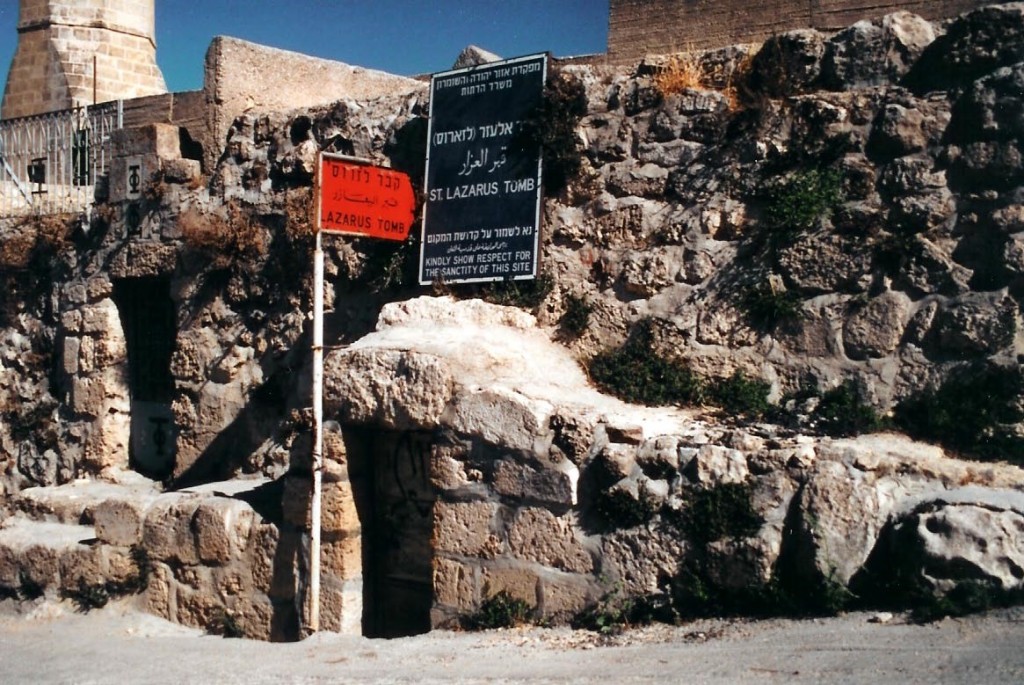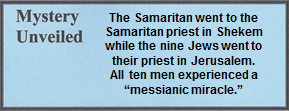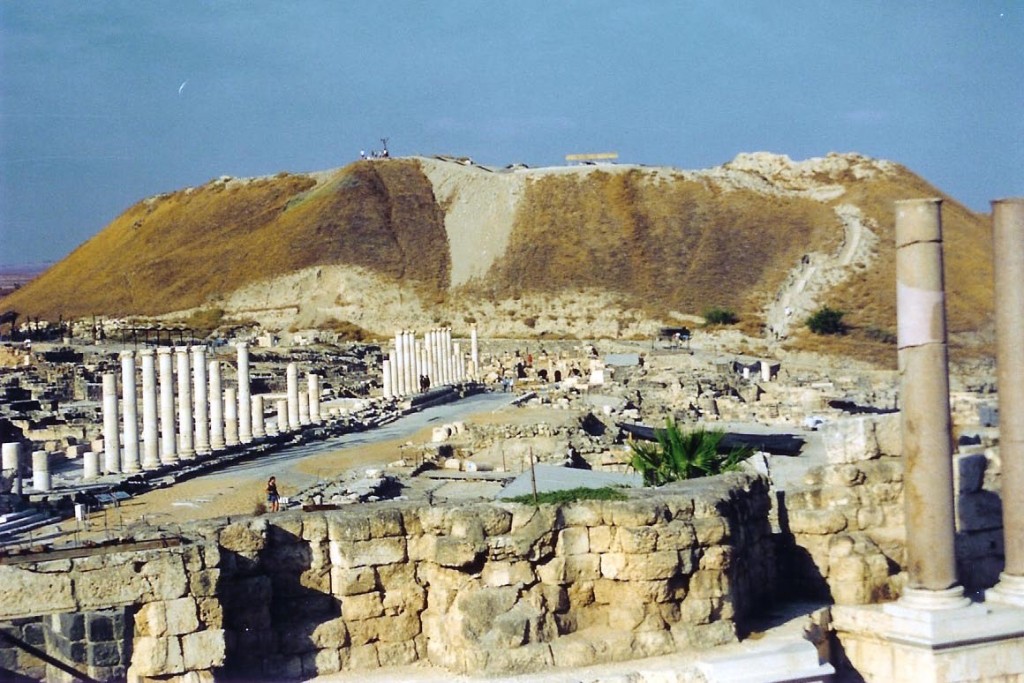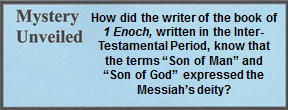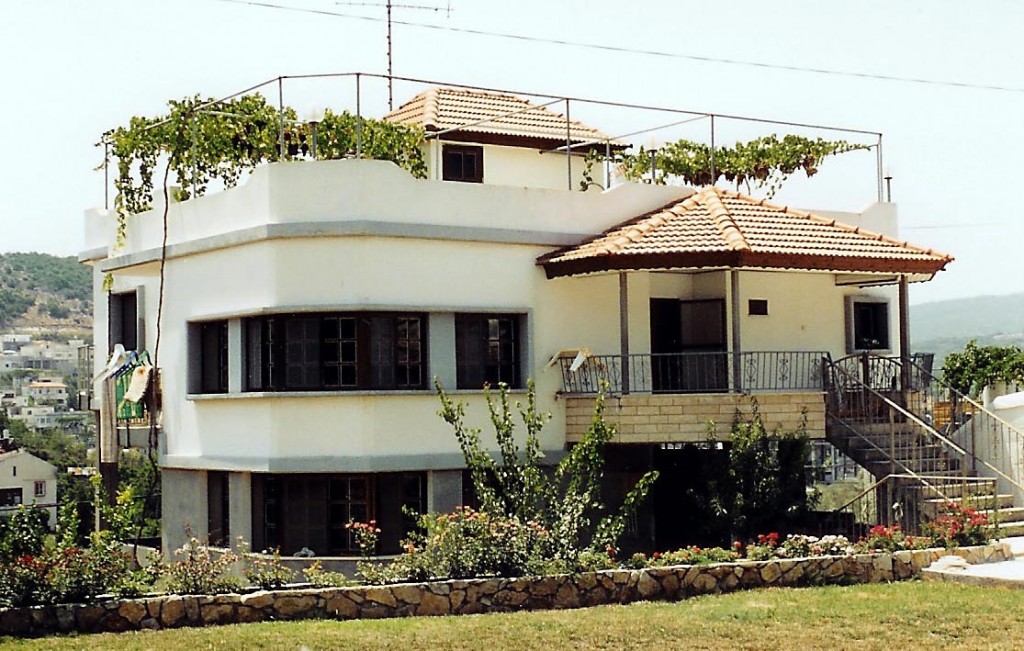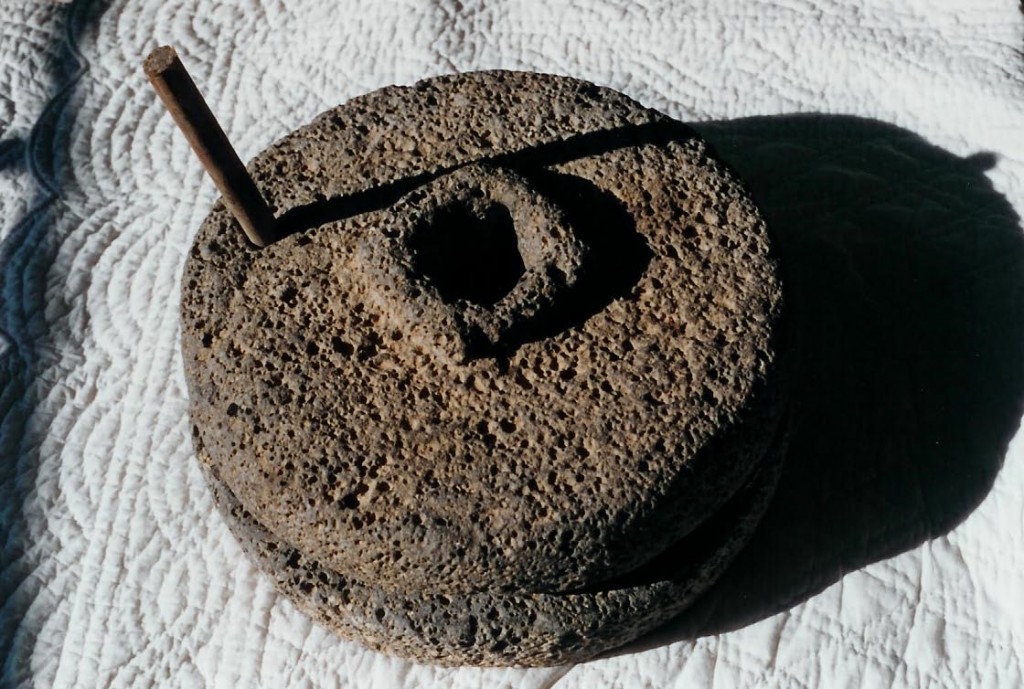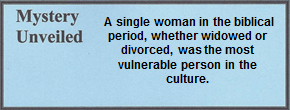12.03.10 Jn. 11:1-37 Bethany
THE MIRACLE OF LAZARUS
1 Now a man was sick, Lazarus, from Bethany, the village of Mary and her sister Martha. 2 Mary was the one who anointed the Lord with fragrant oil and wiped His feet with her hair, and it was her brother Lazarus who was sick. 3 So the sisters sent a message to Him: “Lord, the one You love is sick.”
4 When Jesus heard it, He said, “This sickness will not end in death but is for the glory of God, so that the Son of God may be glorified through it.” 5 Now Jesus loved Martha, her sister, and Lazarus. 6 So when He heard that he was sick, He stayed two more days in the place where He was. 7 Then after that, He said to the disciples, “Let’s go to Judea again.”
8 “Rabbi,” the disciples told Him, “just now the Jews tried to stone You, and You’re going there again?”
9 “Aren’t there 12 hours in a day?” Jesus answered. “If anyone walks during the day, he doesn’t stumble, because he sees the light of this world. 10 If anyone walks during the night, he does stumble, because the light is not in him.” 11 He said this, and then He told them, “Our friend Lazarus has fallen asleep, but I’m on My way to wake him up.”
12 Then the disciples said to Him, “Lord, if he has fallen asleep, he will get well.”
13 Jesus, however, was speaking about his death, but they thought He was speaking about natural sleep. 14 So Jesus then told them plainly, “Lazarus has died. 15 I’m glad for you that I wasn’t there so that you may believe. But let’s go to him.”
16 Then Thomas (called “Twin”) said to his fellow disciples, “Let’s go so that we may die with Him.”
17 When Jesus arrived, He found that Lazarus had already been in the tomb four days. 18 Bethany was near Jerusalem (about two miles away). 19 Many of the Jews had come to Martha and Mary to comfort them about their brother. 20 As soon as Martha heard that Jesus was coming, she went to meet Him. But Mary remained seated in the house.
21 Then Martha said to Jesus, “Lord, if You had been here, my brother wouldn’t have died. 22 Yet even now I know that whatever You ask from God, God will give You.”
23 “Your brother will rise again,” Jesus told her.
24 Martha said, “I know that he will rise again in the resurrection at the last day.”
25 Jesus said to her, “I am the resurrection and the life. The one who believes in Me, even if he dies, will live. 26 Everyone who lives and believes in Me will never die — ever. Do you believe this?”
27 “Yes, Lord,” she told Him, “I believe You are the Messiah, the Son of God, who comes into the world.”
28 Having said this, she went back and called her sister Mary, saying in private, “The Teacher is here and is calling for you.”
29 As soon as she heard this, she got up quickly and went to Him. 30 Jesus had not yet come into the village but was still in the place where Martha had met Him. 31 The Jews who were with her in the house consoling her saw that Mary got up quickly and went out. So they followed her, supposing that she was going to the tomb to cry there.
32 When Mary came to where Jesus was and saw Him, she fell at His feet and told Him, “Lord, if You had been here, my brother would not have died!”
33 When Jesus saw her crying, and the Jews who had come with her crying, He was angry in His spirit and deeply moved. 34 “Where have you put him?” He asked.
“Lord,” they told Him, “come and see.”
35 Jesus wept.
36 So the Jews said, “See how He loved him!” 37 But some of them said, “Couldn’t He who opened the blind man’s eyes also have kept this man from dying?”
Scholars believe the miracles of raising Lazarus back to life was about six weeks prior to Jesus making His triumphal entry into Jerusalem.[1] Jesus was incredibly popular among the people and this miracle only heightened the expectation that He was the long awaited political-messiah. This miracle also intensified the threat the religious leaders felt, that, if Jesus really would declare Himself to be the messiah, their wealthy aristocratic lifestyles would be ruined.
“Bethany” This small village was located east of Jerusalem on the eastern side of the Mount of Olives. It was well known for its dates and figs, in fact, its name means the place for dates.[2] The village was just beyond a Sabbath’s Day walk from the city walls and was adjacent to another village, Bethpage, whose name means the place for the green or winter fig.[3] Church father Origen (A.D. 184/85 – 253/54) said that Bethpage was a village of priests.[4] That would be logical since the village was close to the temple, and being outside the city village residents could have their own gardens.
It has been suggested that the reason Jesus may have chosen to stay with friends in Bethany is because, for many months there were constant threats upon His life.[5] When He was praying in the Garden of Gethsemane, He asked the disciples to keep watch – probably for the same reason – and they failed to perform as requested. But in this village He was safe with friends and yet close to Jerusalem.
“Thomas (called Didymus).” The Hebrew name Thomas and its Greek counterpart Didymus, both mean twin. Obviously, there is the possibility that the apostle had a twin brother, who either died previously or for an unknown reason remained outside of recorded Scripture.
The resurrection was also the sign of Jonah that had been prophesied. Previously when Jesus resurrected someone, the event was somewhat private and those who witnessed it were told not to tell anyone. But of course, such a profound event never remains silent. The gospel writers also dedicated only a few lines to those miracles. But the miracle of Lazarus is in sharp contrast, because as multitudes watched, it forced everyone to make a decision on the identity of Jesus. The significance of this miracle cannot be understated, because it was the final motivation of the Jewish leadership to have Jesus put to death.[6]
Jesus was about to be crucified. His ministry to the public was almost over and He was spending most of His time and effort building up the faith of His disciples. This miracle had to do more with His authenticating His person to the disciples than to the community of believers who happened to witness this event. The faith of these men was going to be shattered when Jesus would be crucified. They would have unending questions. Yet when He would rise to life, so likewise their faith would rise to life. This miracle would eventually help them place Jesus, His teachings and miracles, into perspective.
By the time Jesus arrived at the tomb of Lazarus, the body was wrapped in grave clothes and spices had been placed over it to reduce the offensive odor of the decaying body. The tomb was whitewashed to mark the site (to prevent anyone becoming defiled) and a stone was rolled over the entrance to prevent wild animals from devouring the body. The foul odor of death from the tomb left no question in the mind of witnesses that their friend was dead and his body was in the process of decaying.
Then one of the women said to Jesus, “If you had been here,” Lazarus would still be alive. As with the centurion whose son was ill in Capernaum (Jn. 4:46-54), these women believed Jesus had to be present to manifest a healing on someone who was still alive. They believed the healing power of Jesus was limited to only the living. With sternness, yet lovingly, the woman chided Him for not coming sooner. Jesus, then demonstrated His divine authority over Jewish superstitions and death.
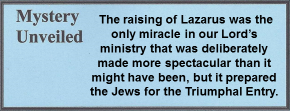
12.03.10.Q1 Why did Jesus wait for four days to raise Lazarus up from the dead (Jn. 11:1-37)?
In this historical account, the immediate question pertains to the reason of why Jesus delayed his return to the home of His very good friends in light of the emergency they faced. Had He no compassion upon them? The issue here is not one of compassion or friendship. Jesus delayed His return to provide Himself the opportunity to show that He was the Creator of life and the Son of God. There are four reasons:
- It was the custom of all Middle Eastern cultures, as it is today, to bury a body on the same day as death occurred.[7] The semi-arid climate conditions will cause decomposition to occur immediately.
- The Pharisees believed the soul hovered over the body for three days after death, because, in the event of a “resurrection,” the person would have a soul when life returned. This tradition may have originated when someone became unconscious due to an injury and awoke two or three days later (a “resurrection”). Nonetheless, in that sense it was believed there was no hope of a resurrection after three days. Jesus proved, beyond any shadow of doubt, that Lazarus was dead before bringing a dead smelly Lazarus back to life. As a result, even the Pharisees and Sadducees could not challenge this issue.[8]
After three days of decomposition, the eyes of the deceased had decayed, the face was hardly recognizable, maggots have infested the corpse and, therefore, it was believed that there was no hope of a resurrection.[9] The Mishnah reflects the common opinion held from the days of Jesus:
For it has been taught, “They adduce evidence as to a corpse’s identity only from the features of the face, including the nose, and they give testimony only within three days [of the deceased’s death].”
Mishnah, Yebamoth 16:3
Later, from an eighth century post-Talmudic tractate, additional clarification on this subject is insightful, even though it well outside the acceptable time period for this study. It reads,
“We go out to the cemetery and examine the dead [to see if they are still alive and have been buried by mistake] for a period of three days and do not fear being suspected of engaging in the ways of the Amorites [i.e., superstitious practices]. Once a man who had been buried was examined and found to be alive; he lived for twenty-five years more and then died. Another such person lived and had five children before he died.”
S’machot 8:1[10]
- It was the custom that after the passing of someone, there were thirty days of mourning.
- . The first three days were for weeping.[11] Some scholars believe that during these days, phylacteries were not worn, fasting was common (not a complete fast, eating an egg or lentils was permitted the first seven days),[12] and the mourners did not greet other people. However, it is unknown if this was a first century practice in the Holy Land or if this was a later cultural practice.[13]
- The following seven days were for lamentation. But this time frame included the fourth day which was known as the high day of mourning. It was believed that on day his soul departed and went to sheol (Hades) never to return.[14] In essence, to rephrase his condition in a modern term, “he was good and dead.”[15 Therefore, a fourth day event was truly a resurrection from death to life – that in the Jewish mind, only God could perform. It was also a silent attack against those who claimed Jesus performed miracles with demonic powers, for it was believed that demons could kill, but not restore or create life.
- The balance of the thirty days for intermission from washing their clothes and shaving.[16]
- Jesus always brings understanding of Himself to the level of comprehension of those to whom He desires to show His love and compassion. It was believed that only God could raise a person back to life immediately after death, but it was also believed that not even God could raise anyone once the body began to decay. Therefore, Jesus demonstrated that His power of life was far beyond their concept of God. The primary reason Jesus delayed His arrival by four days was because He was about to perform a miracle greater than His messianic miracles – miracles the Jews believed that only the true messiah could perform.[17] This miracle was more than just raising a dead person back to life — an astounding feat by itself—but Jesus also proclaimed His deity without a single spoken word! Because only God can give life!
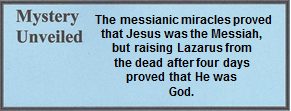
- In the gospels, especially in the book of John, it appears that Jesus moved on His own initiative. He was never pressured to do anything and never in a hurry – but always functioned in His timing. When Mary came to Jesus, He essentially told her that He would come in His time and in His way.
“To cry there…crying…crying.” The Greek word klaio means, to wail loudly, as in loud lamentation or loud weeping.[18] It was the custom, and still continues to be, that to comfort the grieving family professional mourners were employed to weep loudly – an exercise of comfort that is generally not understood by modern Westerners.
“Jesus wept.” The Greek word dakryo means to weep silently.[19] This short sentence reflects the great compassion Jesus had for his dearest friends. All too often, those who declare this to be the shortest verse of Scripture fail to see that it is in fact, the deepest verse. The compassion of Jesus for the human condition is immense. Believers all too often fail to recognize this. This condition is more than an illness that ends physical life, but is the effect of the original sin. In this case, the death of Lazarus meant his two unmarried sisters would be without financial support and, therefore, would be condemned to a life of poverty. From the moment Jesus heard of the illness of Lazarus, He knew that He was about to raise him from death. So why did Jesus weep?
Jesus wept because He recognized all too well the effects of sin on the lives of those He so dearly loved. It brought forth physical, as well as spiritual death. Jesus mourned for their affliction and the effect of sin upon humanity, yet He knew the glorious future that lies ahead of those who follow Him. Some scholars have suggested that the reason Jesus wept was that he looked into the future and saw the incredible destruction that would come upon the people of Jerusalem in the years 70 and 135, along with the eviction from the Holy City. The Roman historian Cassius Dio Cocceianus in A.D. 222 said that as the result of the Simon bar Kokhba in the year 135, about 580,000 Jewish men were killed in various raids and battles and 985 villages were razed to the ground. The number who died from disease and famine could not be counted.[20] There is little question that when Jesus envisioned this horrific future event, He wept, but His primary sorrow was the effects of sin upon humanity.
In raising Lazarus and others from death, Jesus demonstrated that He was God. Words did not have to be spoken. Two previous prophets, Elijah and Elisha, as well as two apostles, Paul and Peter, also raised the dead back to life. However, each declared the miracle to be the work of our Lord and not of their strength or action. But here Jesus performed a miracle in His own authority.
A point of interest should be noted in this narrative. Lazarus had a typical Jewish burial that included wrapping the body in the customary manner. That meant his head, arms, and legs were tightly wrapped with linens. The mystery remains of how he was able to get up and walk out of the tomb and see where he was going. Nonetheless, while Jesus raised him from the grave, He asked the people around him to remove the burial clothes. This was another demonstration where the God of Life desires His followers to participate in miracles.
“Couldn’t He who opened the blind man’s eyes also have kept this man from dying?” This was not just a passing statement, but a reflection on the messianic miracles that Jesus performed. The idea that Jesus could be God incarnate was still to be discovered.
[1]. Bookman, When God Wore Sandals. CD Trac 11, 12.
[2]. Geikie, The Life and Words of Christ. 2:401.
[3]. Geikie, The Life and Words of Christ. 2:401.
[4]. Origen, Commentary on Matthew. 16, 17 on Matthew 21:1.
[5]. Farrar, The Life of Christ. 383.
[6]. Nelesen, Yeshua; the Promise, the Land, the Messiah. (Video Tape 2).
[7]. Babylonian Talmud, Mo’ed Katan 28a (Mid-Festival Days); Babylonian Talmud, Sanhedrin 46b.
[8]. Gilbrant, “John.” 315; Moseley, Yeshua: A Guide to the Real Jesus and the Original Church. 123; Vincent, Word Studies in the New Testament. 2:206.
[9]. Pickup, “ ‘On the Third Day’: The Time Frame of Jesus’ Death and Resurrection.” 522-23; Lang, Know the Words of Jesus. 330.
[10]. Quoted by Stern, Jewish New Testament Commentary. 190-91.
[11]. Lightfoot, A Commentary on the New Testament from the Talmud and Hebraica. 3:363-64.
[12]. Geikie, The Life and Words of Christ. 2:330.
[13]. Lightfoot, A Commentary on the New Testament from the Talmud and Hebraica. 3:366. It is a constant challenge to isolate the first century Jewish cultural norms from later practices.
[14]. Fruchtenbaum, The Jewish Foundation of the Life of Messiah: Instructor’s Manual. Class 18, page 15; Lightfoot, A Commentary on the New Testament from the Talmud and Hebraica. 3:367.
[15]. The belief that the soul remained in the corpse for three days was known in other cultures as well. See Pickup. “ ‘On the Third Day’: The Time Frame of Jesus’ Death and resurrection.” 522 n51.
[16]. Lightfoot, A Commentary on the New Testament from the Talmud and Hebraica. 3:363-64.
[17]. For a description of the three messianic miracles, see 06.03.08.Q1, 06.03.08.Q2, 06.01.03, John 4:25 as well as the related video link 08.03.08.V. See also the comparison of Dead Sea Scroll fragments 4Q278 and 4Q521 with Luke 4:16-30 at 06.02.02; Fischer, The Gospels in Their Jewish Context. (Lecture on CD/MP3). Week 10, Session 2.
[18]. See also Mt. 2:18; Mk. 5:38; Lk. 6:21; 7:32; Vincent, Word Studies in the New Testament. 2:204; Fruchtenbaum, The Jewish Foundation of the Life of Messiah: Instructor’s Manual. Class 18, pages 14-15.
[19]. Vincent, Word Studies in the New Testament. 2:204-05; Fruchtenbaum, The Jewish Foundation of the Life of Messiah: Instructor’s Manual. Class 18, pages 14-15.
[20]. Dio Caccius, Roman History 69.14; http://orion.it.luc.edu/~avande1/jerusalem/sources/cassiusDio-69.htm. Retrieved November 25, 2012.
